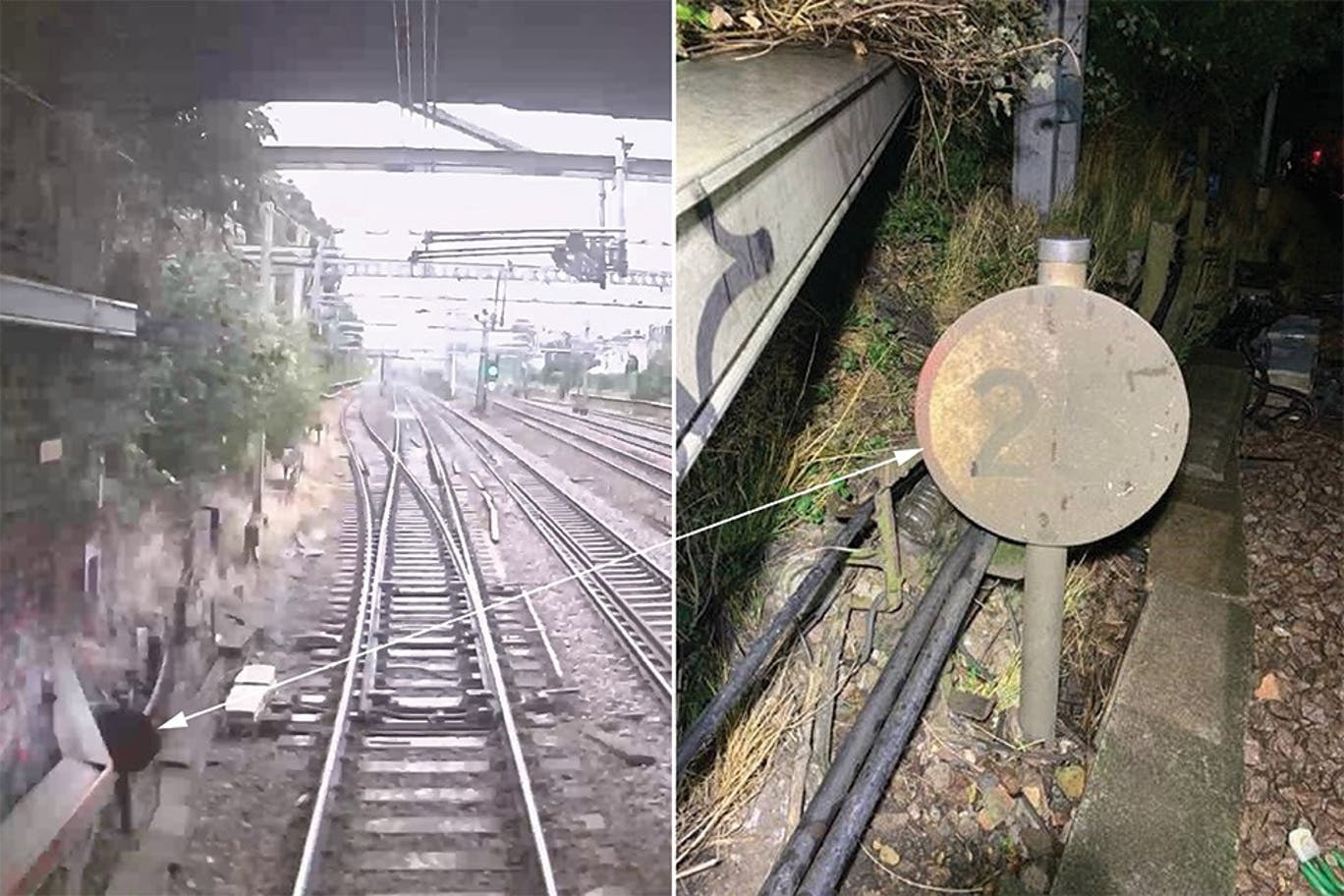|
ChrisB
|
 |
« on: January 29, 2025, 16:39:27 » |
|
From the IndependentTravelling at almost double the speed limit caused the train to ‘jolt sideways’ A speeding Elizabeth line train caused passengers to “lose their footing” after the driver “became confused” about the rerouted train’s location, a report has revealed. According to the Rail Accident Investigation Branch ( RAIB▸ ), the train was travelling at 45mph (72km/h), 20mph faster than the maximum speed for the junction, after being diverted because of a track circuit failure on 24 September 2024. At least one passenger “fell to the floor” on the Heathrow to Shenfield service as the train “jolted sideways” near Manor Park station, CCTV▸ footage shows. After being “routed off its booked route”, the driver became “confused about the train’s location” and failed to reduce the train’s speed to 25mph, the report found. A member of staff onboard reported the overspeed to MTR control as the driver “did not believe” that the jolt was “severe enough to report”. RAIB’s investigation recommends that route risk assessments “identify the opportunities needed for drivers to effectively refresh their route knowledge, particularly where there are alternative routings available”. The RAIB added that an “incorrectly placed, inconspicuous and dirty” 25mph speed limit sign was partly to blame for the incident. Network Rail is responsible for maintaining infrastructure, including permissible speed restriction signs, on the Elizabeth line. There is no in‑cab indication given to Elizabeth line drivers about permissible speeds on their route.  “At the time of the incident, the sign was positioned under the bridge, and partially obscured by lineside equipment, which made it difficult to see. It was also covered in dirt, further reducing its conspicuity and legibility,” said the rail safety investigator. Network Rail’s “Track Work Instruction” guide on ‘How to maintain signs’ states that signs should be kept clean and in good repair. Director of the Elizabeth line Howard Smith said: "We apologise to customers who were on board the train during this rare incident."
|
|
|
|
|
 Logged
Logged
|
|
|
|
|
broadgage
|
 |
« Reply #1 on: January 30, 2025, 02:58:54 » |
|
On such a new and expensive railway, I am surprised that there is no in cab display of the maximum permitted speed.
In the absence of such technology, some cleaning of the speed limit signs is required, and possibly re-locating same to improve sighting.
It is reassuring though that a train travelled at nearly twice the permitted speed without any serious consequences. I suspect that doing 100 mph in a car on a narrow country lane would be more dangerous.
|
|
|
|
|
 Logged
Logged
|
A proper intercity train has a minimum of 8 coaches, gangwayed throughout, with first at one end, and a full sized buffet car between first and standard.
It has space for cycles, surfboards,luggage etc.
A 5 car DMU▸ is not a proper inter-city train. The 5+5 and 9 car DMUs are almost as bad.
|
|
|
|
Mark A
|
 |
« Reply #2 on: January 30, 2025, 10:04:41 » |
|
Given the lead distance, by the time the driver's within sight of that '25' sign, not sure what he's meant to do about it. Perhaps there's something else set further back.
Mark
|
|
|
|
|
 Logged
Logged
|
|
|
|
|
Ralph Ayres
|
 |
« Reply #3 on: January 30, 2025, 10:36:24 » |
|
Given the lead distance, by the time the driver's within sight of that '25' sign, not sure what he's meant to do about it. Perhaps there's something else set further back.
As I understand things, it mostly relies on the driver's training and paying attention to the preceding signal which would have indicated that a turnout was being taken; that's why there is such an emphasis on route-learning, and one of the demands often quoted when drivers' reasonably generous pay is discussed. The speed limit sign itself even if clean and well-positioned is unlikely to be seen from far enough away to form the main instruction, and is not intended to do so. It really just means "This is the exact point where the speed restriction you are already expecting starts", and if the drop in speed is significant there is an advance warning sign. Reading the RAIB▸ Safety Digest https://assets.publishing.service.gov.uk/media/6798ebbf4686aac15860641e/D012025_250127_Manor_Park.pdf I'm not sure the driver would have driven differently if the sign had been more visible. |
|
|
|
|
 Logged
Logged
|
|
|
|
|
grahame
|
 |
« Reply #4 on: January 30, 2025, 10:53:57 » |
|
Given the lead distance, by the time the driver's within sight of that '25' sign, not sure what he's meant to do about it. Perhaps there's something else set further back.
Mark
The fundamental difference between a tram and a train? For a tram or a bus, it's driven within line of sight, no route knowledge needed, and signage needs to be visible at a distance where action can be taken. For trains, routes need to be learned and the signage may be considered as an aid to route learning, so need not be visible from further back. Probably a good idea to help the route learning by having the signs clean enough to read though! |
|
|
|
|
 Logged
Logged
|
Coffee Shop Admin, Chair of Melksham Rail User Group, TravelWatch SouthWest Board Member
|
|
|
|
stuving
|
 |
« Reply #5 on: January 30, 2025, 11:46:50 » |
|
On such a new and expensive railway, I am surprised that there is no in cab display of the maximum permitted speed.
But this isn't a new railway, is it? It's the old Shenfield Electrics line, and has been running a high frequency (i.e metro) service since 1949. As a result, it needed far less done to it to tack it onto the end of Crossrail than the GW▸ suburban line, which had never been developed in the same way earlier on. The current EL service is nearly doble the five or so trains per hour it had before, but that hardly calls for a big change to the track. Of course someone ought to have cleaned the sign, whatever the service. Perhaps the PW▸ maintenance staff couldn't see it? |
|
|
|
|
 Logged
Logged
|
|
|
|
|
Trowres
|
 |
« Reply #6 on: January 30, 2025, 22:02:28 » |
|
The RAIB▸ report does not state the speed limit on the main (non-diverging) line, but it does say that the train's speed (45mph) was within the limit, so we can conclude that the non-diverging route's limit was at least 45mph.
The RAIB report also states that the speed restriction sign (see photo above in the thread) should have had a left-hand arrow (to indicate that the 25 applied to the diverging route).
Without the arrow, the 25mph would mean that the restriction applied to both routes, would it not? In which case, I'm surprised that the RAIB report makes no mention of this. How many trains passed the sign at 45+mph (drivers' route knowledge of the speed restriction on the main route ) and how many were surprised by the 25 sign. How many did or didn't report the anomaly?
|
|
|
|
|
 Logged
Logged
|
|
|
|
|
GBM
|
 |
« Reply #7 on: January 31, 2025, 10:45:53 » |
|
The fundamental difference between a tram and a train? For a tram or a bus, it's driven within line of sight, no route knowledge needed, and signage needs to be visible at a distance where action can be taken. For trains, routes need to be learned and the signage may be considered as an aid to route learning, so need not be visible from further back. Probably a good idea to help the route learning by having the signs clean enough to read though!
Whoa there. Bus drivers - no route knowledge needed? All part of their initial training once they've passed their test is to go out with a buddy/experienced driver and learn the various routes, plus learning which ones you can't take. Also driving the different vehicles types. Only once the buddy is happy is the trainee 'released into the wild' going solo. |
|
|
|
|
 Logged
Logged
|
Personal opinion only. Writings not representative of any union, collective, management or employer. (Think that absolves me...........)  |
|
|
|
broadgage
|
 |
« Reply #8 on: February 01, 2025, 04:31:06 » |
|
On such a new and expensive railway, I am surprised that there is no in cab display of the maximum permitted speed.
But this isn't a new railway, is it? It's the old Shenfield Electrics line, and has been running a high frequency (i.e metro) service since 1949. As a result, it needed far less done to it to tack it onto the end of Crossrail than the GW▸ suburban line, which had never been developed in the same way earlier on. The current EL service is nearly double the five or so trains per hour it had before, but that hardly calls for a big change to the track. Of course someone ought to have cleaned the sign, whatever the service. Perhaps the PW▸ maintenance staff couldn't see it? Yes, I know that it was not newly built, but presumed that significant updating and improvement took place. |
|
|
|
|
 Logged
Logged
|
A proper intercity train has a minimum of 8 coaches, gangwayed throughout, with first at one end, and a full sized buffet car between first and standard.
It has space for cycles, surfboards,luggage etc.
A 5 car DMU▸ is not a proper inter-city train. The 5+5 and 9 car DMUs are almost as bad.
|
|
|
|
Electric train
|
 |
« Reply #9 on: February 11, 2025, 06:44:05 » |
|
On such a new and expensive railway, I am surprised that there is no in cab display of the maximum permitted speed.
But this isn't a new railway, is it? It's the old Shenfield Electrics line, and has been running a high frequency (i.e metro) service since 1949. As a result, it needed far less done to it to tack it onto the end of Crossrail than the GW▸ suburban line, which had never been developed in the same way earlier on. The current EL service is nearly double the five or so trains per hour it had before, but that hardly calls for a big change to the track. Of course someone ought to have cleaned the sign, whatever the service. Perhaps the PW▸ maintenance staff couldn't see it? Yes, I know that it was not newly built, but presumed that significant updating and improvement took place. The underlying design and costing of "Crossrail" was based on using existing infrastructure on the Great Eastern and Great Western main lines the exception was the addition of electrification West of Airport Junction to Maidenhead. The lack of incab signalling is a risk although AWS▸ and TPWS▸ do mitigate this to an extent. Just as a note line speed signs are a signalling asset and not PW |
|
|
|
|
 Logged
Logged
|
Starship just experienced what we call a rapid unscheduled disassembly, or a RUD, during ascent,”
|
|
|
|
onthecushions
|
 |
« Reply #10 on: Yesterday at 18:06:07 » |
|
Reading elsewhere, the preceding signal had the letters, "DA▸ " underneath (a rarely used down avoiding line) rather than a left hand feathers. Three separate signalling systems in one journey is demanding. The trackside "home" sign even if clean is too late for corrective action (no overlap); the distant sign is more relevant.
A road vehicle's GPS has complex maps and also road speed limits superimposed. A similar rail system should be simpler and a useful drivers' aid, which the expensive signalling system was not in this case.
As far as bus crews' route knowledge is concerned, I remember several times on the return bus from Bracknell, the (Alder/Thames Valley) conductor turning to us passengers and asking, "anyone know the way back to Reading?".
OTC
|
|
|
|
|
 Logged
Logged
|
|
|
|
|
GBM
|
 |
« Reply #11 on: Today at 07:19:48 » |
|
As far as bus crews' route knowledge is concerned, I remember several times on the return bus from Bracknell, the (Alder/Thames Valley) conductor turning to us passengers and asking, "anyone know the way back to Reading?".
OTC
Yes, one of my early runs involved a bit of a route I'd never done, so did a shout out to passengers. The lady's husband had been a driver on that route years ago. Back for a meal break, and discussed this, only to be told the way I went was old "We don't use that nowadays as our now larger vehicles get stuck on the sharp bend". Oops. No, I didn't get stuck, just another tight turn for me......... |
|
|
|
|
 Logged
Logged
|
Personal opinion only. Writings not representative of any union, collective, management or employer. (Think that absolves me...........)  |
|
|
|





